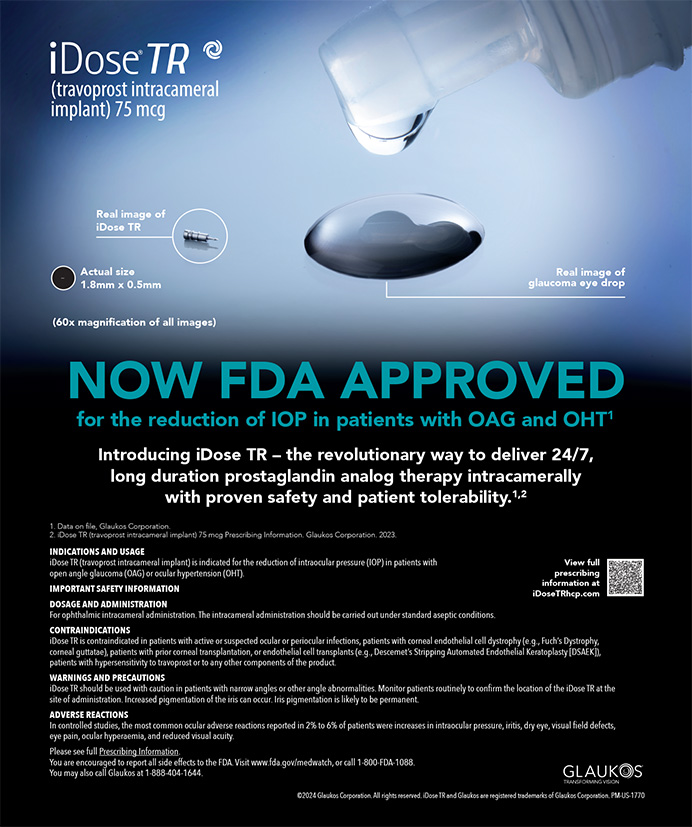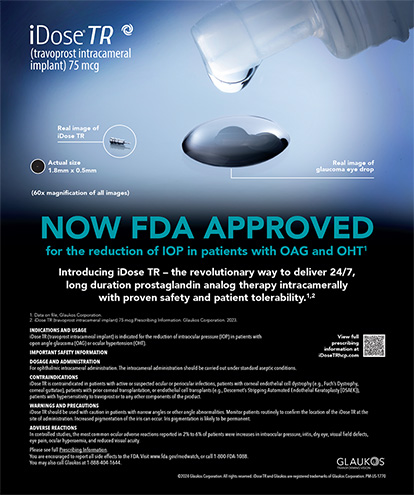The presence of anesthesia personnel at cataract surgery is a standard of care meant to ensure that the surgeon can focus on achieving a safe and effective outcome while the anesthesiologist or nurse anesthetist focuses on patient comfort. Suggesting that the surgeon should handle both roles simultaneously is misguided and dangerous, according to cataract surgeons reacting to a guideline recently promulgated by Anthem Blue Cross Blue Shield, a major insurance provider.
The guideline was posted on Anthem’s website on February 1.1 In response to concerns expressed by organized ophthalmology representatives and individuals, Anthem has since clarified that the guideline is “not implemented at this time.” A portion of the document, titled “Monitored Anesthesia Care and General Anesthesia for Cataract Surgery,” is reproduced in the sidebar on the following page.
Publication of the statement was met with a groundswell of opposition from state and federal ophthalmology and anesthesiology associations and from individual providers.
Elizabeth Yeu, MD, of Virginia Eye Consultants, told CRST, “I truly cannot see how this could benefit anything other than Anthem’s profit and loss sheets. Lack of anesthesia support will ultimately lend itself to lower patient satisfaction scores, at the very minimum, with routine and uncomplicated cases, but I am even more concerned about the greater potential for complications and longer intraoperative times that will inevitably occur as a result of the greater anxiety and discomfort patients will experience.”
David Glasser, MD, AAO Secretary for Federal Affairs, told CRST that the AAO has made its position clear to Anthem. “Our stance has been that anesthesia personnel are key to the safety and effectiveness of cataract surgery, and an ophthalmologist cannot administer sedation and monitor the patient and do the surgery all at the same time. Those are the key points we have expressed to them. They listened, and they are thinking about it.”
Anthem, which offers commercial insurance plans in 14 states, maintains its stance that anesthesia needs vary, and therefore so should coverage. According to a statement provided by a company spokesperson, “Anthem’s Medical Policy & Technology Assessment Committee reviewed the available evidence addressing the use of general anesthesia and monitored anesthesia care for cataract surgery. According to the literature reviewed, there is no one definitive approach regarding the use of anesthesia for cataract surgery, and patient-specific needs should be taken into consideration, as well as potential risk of harm to individuals who are sedated during surgical procedures. Anthem’s guideline allows general anesthesia and monitored anesthesia care for cataract surgery when clinical indications support that they are medically necessary and provides coverage for other forms of anesthesia, including intravenous moderate sedation, without the need for review.”
TIMELINE OF CONTROVERSY
Anthem’s guideline on cataract anesthesia coverage was developed in 2017. On February 1, a clarification was made to the guideline indicating that the policy does not intend to exclude moderate sedation from coverage. The clarification also said that such sedation would have to be managed by the surgeon. It was when the clarification was published that the issue drew the attention of the state and national ophthalmology and anesthesiology associations and individual providers.
Dr. Glasser explained that the administrators responsible for the Anthem cataract anesthesia guideline reviewed the company’s claims data and found that around 20% of cataract cases are done without a corresponding claim for anesthesia services. “Those cases are probably done with minimal or no sedation, probably not requiring IV access, so the risk of a complication is so low that the ophthalmologist and the patient feel comfortable proceeding without anesthesia personnel. However, the vast majority—80% or more—are done with anesthesia personnel in the room. Each case is different, and having the anesthesia personnel there allows the ophthalmologist to focus on the surgery,” he said.
“I think Anthem might not have recognized the degree to which ophthalmologists think the presence of an anesthetist is important,” Dr. Glasser continued. “They may have just looked at their data and said, ‘20% are done without an anesthesiology claim, maybe everybody can do it that way, or maybe most people can do it that way.’ Maybe they just really were not aware, but now they certainly are aware.”
In light of the pushback from the AAO and other organizations, Dr. Glasser said, the company made clear that the guidance had not been implemented, and the company is still “considering what to do.”
Anthem revised the guideline in March to include language indicating that the anesthesia policy had not been implemented. The Anthem statement provided to CRST said, in part, “We value our relationships with providers. We have been and will continue to have a dialogue with our providers and medical societies regarding their concerns.”
Monitored Anesthesia Care and General Anesthesia for Cataract Surgery
Medically Necessary
Administration of monitored anesthesia care (MAC) or general anesthesia for cataract surgery is considered medically necessary for any one of the following:
- Children less than 18 years of age;
- Individuals who are unable to cooperate or communicate (for example, dementia, acute agitation, or movement disorder);
- Individuals who are unable to lie flat (eg, severe back pain, congestive heart failure);
- Individuals who have failed or have contraindications to topical, local, regional, or moderate sedation anesthesia; or
- Anticipation of prolonged or complex surgery.
Not Medically Necessary
Administration of monitored anesthesia care (MAC) or general anesthesia for cataract surgery is considered not medically necessary for all other indications and when criteria above are not met.
*This is an excerpt from: Clinical UM guideline. https://www11.anthem.com/ca/medicalpolicies/guidelines/gl_pw_d056667.htm. Accessed March 21, 2018.
SURGEON REACTION
Vance Thompson, MD, FACS, of Vance Thompson Vision, said Anthem’s policy goes against the Hippocratic Oath. “I took an oath as a physician to ‘do no harm’ and do my best for the patient, and the recent [proposed] ruling by Anthem that in routine cataract surgery an anesthesiologist or a nurse anesthetist is not necessary goes against that. Because you really cannot tell if a cataract surgery is routine until it is over. Things happen, and every situation is different. Sometimes a patient becomes overly anxious, other times a patient might get too sleepy. These are situations I am not qualified to address. If I had to administer and monitor anesthesia, it would take my attention away from doing what I need to do to make the patient’s vision be its best.”
Keith A. Walter, MD, FACS, a professor of ophthalmology at Wake Forest Baptist Medical Center, described the disputed Anthem guideline as “ridiculous.”
“We actually offer patients the option of forgoing anesthesia,” he said, “and out of the 700 cataract cases that I do per year, we typically have no more than one or two takers. The majority are nervous and apprehensive about getting cataract surgery and require 1 mg or sometime 2 mg of [midazolam]; some require up to 10 mg of [midazolam] or even ketamine. I cannot administer those drugs while I am doing cataract surgery; it is not feasible. I cannot do a good job if I have to worry about the patient’s comfort the entire time. We need anesthesiologists; we need [certified registered nurse anesthetists] in our practice.”
NO CLAIMS DENIED
As this article was prepared for press, the AAO was not aware of any anesthesia claims that had been denied by Anthem, according to Dr. Glasser. “The Academy has been spreading the message to ophthalmologists and Academy members that, until we hear further from Anthem, ophthalmologists and the anesthesiologists who are assisting them should continue to submit claims for anesthesia for cataract surgery.”
Dr. Glasser continued, “We have made our position clear to Anthem: We strongly encouraged them not to implement the policy, in fact, to rescind it to end any confusion. Now we are waiting to see what their final decision will be.”
If any AAO members or their anesthesiologist colleagues receive a claim denial from Anthem, Dr. Glasser requested that they forward a redacted copy of the explanation of benefits to the AAO at healthpolicy@AAO.org so that the organization can follow up on it.
“The people at Anthem have told us that they want to hear about it if there have been actual denials because that is not their intent at this time,” Dr. Glasser said.
Dr. Glasser suggested that some of the consternation surrounding this guideline has been related to the manner in which it was communicated. “Physicians and practice managers found it on Anthem’s website and assumed that it was in place and effective as of February 1. There was no communication from Anthem to the practices to make them realize that it was not actively being implemented. Anthem now says that, if they decide to implement it, they will communicate it clearly to the physician community beforehand. We hope that there will be a decision to rescind, but in the worst case scenario if they decide to proceed, we hope they will make it clear by communicating it to the physician community and do so with a long enough lead time that physicians can make alternative plans for their patients.”
WHAT IF?
If Anthem does implement the guideline and begins denying coverage of monitored anesthesia care or general anesthesia in what the insurer deems routine cases, Dr. Glasser said, “most of us would have to have frank conversations with our patients about whether or not an anesthesiologist or nurse anesthetist would be paid for if they had coverage by Anthem. Some cases might be deferred or canceled; other cases might be done without anesthesia support, but I do not think there would be very many. I think the current situation tells us that greater than 80% of cases are done with anesthesia support because the level of sedation is such that IV access and a trained anesthetist is necessary. I do not think we would see a vast number of cases switching over to lower levels of sedation and a nontrained person monitoring the vital signs while the physician does surgery. I think that would be a very small percentage of cases.”
1. Clinical UM guideline. https://www11.anthem.com/ca/medicalpolicies/guidelines/gl_pw_d056667.htm. Accessed March 21, 2018.








